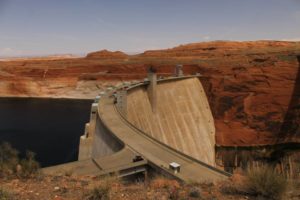“One should admit at the outset to a certain bias. Indeed I am a “butterfly chaser, googly eyed bleeding heart and wild conservative.” I take a dim view on dam: I find it hard to learn to love cement, I am poorly impressed by concrete aggregates and statistics in cubic tons.” -Edward Abbey
 Twelve miles down stream from the Glen Canyon Dam I stand witness to turquoise rapids lapping against the banks of the Colorado River. Something seems amiss- what happened to the chocolate milk flow?
Twelve miles down stream from the Glen Canyon Dam I stand witness to turquoise rapids lapping against the banks of the Colorado River. Something seems amiss- what happened to the chocolate milk flow?
After a month of exploration in the Colorado Plateau I have learned a few things about this region- large bodies of water should pulse with sediment, Fremont’s Cottonwood whispers health, there is always more to uncover.
In the 1940s, the Echo Park Dam proposal caught the nation by surprise. People across the country rushed together to prevent said construction from occurring within the boundaries of the Dinosaur National Monument. The threat to the image of the National Park Service permitted a hasty compromise. Thomas Fliseshner would describe the negotiation governed by a “passion for a concept rather than a place.” Many were unaware the heart of Canyon Country would soon be covered by 100s of feet of halted water.
What was to be obscured?
Looking across the now filled canyon, a certain level of imagination is called forth. No longer can we scale the slick rock walls, following hand- and foot-holds to Ancestral Puebloan ruins. No longer can we walk the passages Homo sapiens called home for the past nine thousand years. Although archaeologists scoured the area prior to the dam’s construction, I sit with the realization no amount of documentation, be it photographs or museum specimens, can replace what has been lost.
April 21, 2015
A Side-blotched Lizard (Uta stansburiana) scurries across railing, sandstone body a stark contrast to concrete. They pause for a moment; possibly pondering the fatal 710’ drop to river bottom. We both find ourselves on the second largest arch-gravity dam in the world.
My intention is to participate in the tour of Glen Canyon Dam as a naturalist, to discover life and see the dam as a habitat. Certainly there is a touch of irony in this approach and yet I am surprised by the similarities of concrete and sandstone walls. Both are porous; an estimated 1600 gallons seep through the dam per minute. Channeled, the water collects at the down-facing base. Here, two Mallards are found bobbing in the wake as it flows into the Colorado River. As for vegetation, none is present aside from the Bermuda grass at the dams’ foot. On adjacent canyon walls, however, moss and Maidenhair Ferns congregate around groundwater sapping cracks. Below, double-crested cormorants perch on round river rocks, seemingly attracted to the non-native trout drawn to the released cold water.
As with many dams in the twenty-first century, the Glen Canyon Dam is filled with controversy. Initially I foresaw a tour of the dam as being an emotionally charged experience. In actuality what I observed north and south of the wall is far more stirring.
Behind the wall, Powell Reservoir stretches 187 miles when full. This massive body of water, with more shoreline than the east coast of the U.S., is insensible. Now, far more barren than native desert, fluctuating water levels have created ephemeral shorelines inhospitable to plant life. Beavers, once common, along with many other critters, are no longer present, lost in the wake of progress.
If the reservoir were to drain before me, a lot of one thing would remain- silt. Of all the particles carried down the many tributaries of the Colorado River, I find myself at the most southern extent of their journey.
My movement, however, is not prohibited like the silt, enabling me to venture south. Because sediment is deposited at the reservoirs floor, only clear water is released. Rufus sandstone against teal flow, though beautiful, reminds of what is absent.
The dam has altered the function of the Colorado River and thus adjacent riparian communities. Without flash floods and alluvium deposits, sandbars have eroded without being replaced. As a result native flora and fauna have declined, specifically by the replacement of Fremont’s Cottonwood with invasive Tamarisk, a plant notorious for drinking copious amounts of water.
Much more could be said. Calcium carbonate deposits on Glen Canyon walls tell a story of dwindling water levels. Silt accumulates more each year. In 1996, the Bureau of Reclamation attributed the loss of 600,000 acre feet of water loss to evaporation, enough to meet the annual domestic needs of two million people. Much more should be said.
Dams are symbolic. They represent humanities ability to suppress, control and domesticate the wild animal within each of us. As I reflect on their nature, I wonder about the color of my own flow, if anything is holding me back from fulfilling my role.
I invite you to do the same.